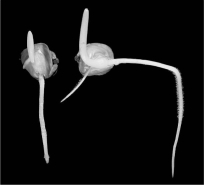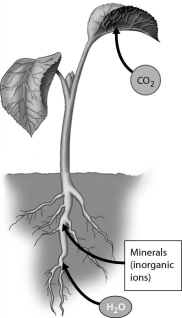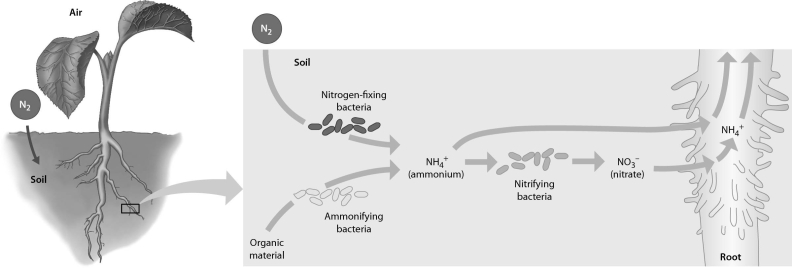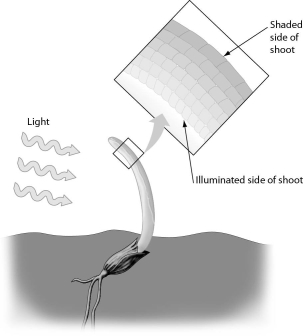Deck 29: The Working Plant
Question
Question
Question
Question
Question
Question
Question
Question
Question
Question
Question
Question
Question
Question
Question
Question
Question
Question
Question
Question
Question
Question
Question
Question
Question
Question
Question
Question
Question
Question
Question
Question
Question
Question
Question
Question
Question
Question
Question
Question
Question
Question

Unlock Deck
Sign up to unlock the cards in this deck!
Unlock Deck
Unlock Deck
1/42
Play
Full screen (f)
Deck 29: The Working Plant
1
What does a plant gain from a mycorrhizal relationship?
A) It allows roots to absorb water and solutes more rapidly.
B) It increases the surface area for photosynthesis.
C) It helps to break down complex molecules in the soil to release micronutrients.
D) It helps to break down decaying organic matter into essential plant nutrients.
A) It allows roots to absorb water and solutes more rapidly.
B) It increases the surface area for photosynthesis.
C) It helps to break down complex molecules in the soil to release micronutrients.
D) It helps to break down decaying organic matter into essential plant nutrients.
A
2
For a plant,carbon and nitrogen are _____.
A) macronutrients
B) micronutrients
C) minerals
D) vitamins
A) macronutrients
B) micronutrients
C) minerals
D) vitamins
A
3
Which one of the following is a plant micronutrient?
A) iron
B) oxygen
C) sulfur
D) phosphorus
A) iron
B) oxygen
C) sulfur
D) phosphorus
A
4
Which of the following best describes the conversion that occurs during nitrogen fixation?
A) ammonium to nitrate
B) nitrate to ammonium
C) nitrogen to ammonium
D) nitrogen to ammonium or nitrate
A) ammonium to nitrate
B) nitrate to ammonium
C) nitrogen to ammonium
D) nitrogen to ammonium or nitrate

Unlock Deck
Unlock for access to all 42 flashcards in this deck.
Unlock Deck
k this deck
5
Which of the following best describes substances that enter a plant through the root system?
A) They are dissolved in water.
B) They are attached to a carbon chain.
C) They are brought in through plasmodesmata.
D) They are brought in through stomata.
A) They are dissolved in water.
B) They are attached to a carbon chain.
C) They are brought in through plasmodesmata.
D) They are brought in through stomata.

Unlock Deck
Unlock for access to all 42 flashcards in this deck.
Unlock Deck
k this deck
6
Most plants rely on bacteria to supply them with a usable form of which of the following substances?
A) nitrogen
B) carbon dioxide
C) water
D) amino acids
A) nitrogen
B) carbon dioxide
C) water
D) amino acids

Unlock Deck
Unlock for access to all 42 flashcards in this deck.
Unlock Deck
k this deck
7
Which of the following best describes the mechanism that causes stomata to open?
A) Water accumulates below the opening and eventually causes the stoma to open.
B) A large bubble of oxygen accumulates below the stoma and eventually causes it to open.
C) Two guard cells flanking each stoma control its opening by changing shape.
D) The internal pressure of xylem sap expands the leaf, stretching the stoma open.
A) Water accumulates below the opening and eventually causes the stoma to open.
B) A large bubble of oxygen accumulates below the stoma and eventually causes it to open.
C) Two guard cells flanking each stoma control its opening by changing shape.
D) The internal pressure of xylem sap expands the leaf, stretching the stoma open.

Unlock Deck
Unlock for access to all 42 flashcards in this deck.
Unlock Deck
k this deck
8
Which of the following convert atmospheric nitrogen to ammonium?
A) nitrifying bacteria
B) nitrogen-fixing bacteria
C) denitrifying bacteria
D) ammonifying bacteria
A) nitrifying bacteria
B) nitrogen-fixing bacteria
C) denitrifying bacteria
D) ammonifying bacteria

Unlock Deck
Unlock for access to all 42 flashcards in this deck.
Unlock Deck
k this deck
9
Which of the following best describes the role of plant root nodules in plants such as peas and beans?
A) They house nitrogen-fixing bacteria.
B) They help absorb nutrients from the soil.
C) They are plant adaptations to kill bacteria that destroy root hairs.
D) They store nutrients.
A) They house nitrogen-fixing bacteria.
B) They help absorb nutrients from the soil.
C) They are plant adaptations to kill bacteria that destroy root hairs.
D) They store nutrients.

Unlock Deck
Unlock for access to all 42 flashcards in this deck.
Unlock Deck
k this deck
10
Mycorrhizae represent a(n)______.
A) parasitic association
B) mutualistic relationship
C) adaptation for photosynthesis
D) competitive interaction
A) parasitic association
B) mutualistic relationship
C) adaptation for photosynthesis
D) competitive interaction

Unlock Deck
Unlock for access to all 42 flashcards in this deck.
Unlock Deck
k this deck
11
Which of the following best describes the essential difference between plant and animal nutrition?
A) Plants use inorganic substances and energy from the sun to produce their own food.
B) Plants use organic substances to produce their own food.
C) Plants absorb food through their roots.
D) Plant and animal nutrition are essentially the same.
A) Plants use inorganic substances and energy from the sun to produce their own food.
B) Plants use organic substances to produce their own food.
C) Plants absorb food through their roots.
D) Plant and animal nutrition are essentially the same.

Unlock Deck
Unlock for access to all 42 flashcards in this deck.
Unlock Deck
k this deck
12
Which of the following best describes the opening and closing of the stomata in most plants?
A) They are open during the day and closed at night.
B) They are open at night and closed during the day.
C) They are open almost all of the time.
D) They are closed except for brief periods of time during the day.
A) They are open during the day and closed at night.
B) They are open at night and closed during the day.
C) They are open almost all of the time.
D) They are closed except for brief periods of time during the day.

Unlock Deck
Unlock for access to all 42 flashcards in this deck.
Unlock Deck
k this deck
13
Which of the following convert soil ammonium to nitrate?
A) nitrifying bacteria
B) ammonifying bacteria
C) denitrifying bacteria
D) nitrogen-fixing bacteria
A) nitrifying bacteria
B) ammonifying bacteria
C) denitrifying bacteria
D) nitrogen-fixing bacteria

Unlock Deck
Unlock for access to all 42 flashcards in this deck.
Unlock Deck
k this deck
14
Which of the following mechanisms best explains how xylem sap moves up against the downward pull of gravity?
A) transpiration-cohesion-tension mechanism
B) adhesion-tension-diffusion of oxygen
C) reverse osmosis-adhesion-transpiration
D) glucose pumping-adhesion-tension mechanism
A) transpiration-cohesion-tension mechanism
B) adhesion-tension-diffusion of oxygen
C) reverse osmosis-adhesion-transpiration
D) glucose pumping-adhesion-tension mechanism

Unlock Deck
Unlock for access to all 42 flashcards in this deck.
Unlock Deck
k this deck
15
Transpiration pulls water up a plant because of two mechanisms: _____ describes water molecules sticking together and _____ describes water molecules sticking to the walls of the xylem.
A) cohesion...adhesion
B) adhesion...cohesion
C) adhesion...gravity
D) gravity...cohesion
A) cohesion...adhesion
B) adhesion...cohesion
C) adhesion...gravity
D) gravity...cohesion

Unlock Deck
Unlock for access to all 42 flashcards in this deck.
Unlock Deck
k this deck
16
Which of the following best describes transpiration?
A) the loss of oxygen from a plant
B) evaporation from a plant's roots
C) the bulk flow movement of water in a plant
D) the loss of water from plant leaves through evaporation
A) the loss of oxygen from a plant
B) evaporation from a plant's roots
C) the bulk flow movement of water in a plant
D) the loss of water from plant leaves through evaporation

Unlock Deck
Unlock for access to all 42 flashcards in this deck.
Unlock Deck
k this deck
17
The three most important nutrients contained in fertilizers are ______.
A) nitrogen, iron, and phosphorus.
B) zinc, sulfur, and phosphorus.
C) nitrogen, phosphorus, and potassium.
D) zinc, iron, and potassium.
A) nitrogen, iron, and phosphorus.
B) zinc, sulfur, and phosphorus.
C) nitrogen, phosphorus, and potassium.
D) zinc, iron, and potassium.

Unlock Deck
Unlock for access to all 42 flashcards in this deck.
Unlock Deck
k this deck
18
Which of the following describes a chemical element that a plant must obtain from its environment in order to complete its life cycle?
A) macronutrient
B) micronutrient
C) essential element
D) mineral
A) macronutrient
B) micronutrient
C) essential element
D) mineral

Unlock Deck
Unlock for access to all 42 flashcards in this deck.
Unlock Deck
k this deck
19
Which of the following supplies water and absorbed nutrients to a typical plant?
A) the air
B) its sap
C) sunlight
D) the soil
A) the air
B) its sap
C) sunlight
D) the soil

Unlock Deck
Unlock for access to all 42 flashcards in this deck.
Unlock Deck
k this deck
20
Which of the following weather conditions would cause transpiration to be most rapid?
A) hot, humid weather
B) cold, humid weather
C) hot, dry weather
D) windy, wet weather
A) hot, humid weather
B) cold, humid weather
C) hot, dry weather
D) windy, wet weather

Unlock Deck
Unlock for access to all 42 flashcards in this deck.
Unlock Deck
k this deck
21
Which of the following describes how phloem sap moves within a plant?
A) bulk-flow mechanism
B) sugar-flow mechanism
C) pressure-flow mechanism
D) sink-to-source mechanism
A) bulk-flow mechanism
B) sugar-flow mechanism
C) pressure-flow mechanism
D) sink-to-source mechanism

Unlock Deck
Unlock for access to all 42 flashcards in this deck.
Unlock Deck
k this deck
22
The figure below illustrates ______ in plants. 
A) photoperiod
B) gravitropism
C) thigmotropism
D) phototropism

A) photoperiod
B) gravitropism
C) thigmotropism
D) phototropism

Unlock Deck
Unlock for access to all 42 flashcards in this deck.
Unlock Deck
k this deck
23
Which of the following is the site of carbon dioxide uptake by a plant? 
A) root hairs
B) leaves
C) rhizomes
D) internodes

A) root hairs
B) leaves
C) rhizomes
D) internodes

Unlock Deck
Unlock for access to all 42 flashcards in this deck.
Unlock Deck
k this deck
24
Which of the following best describes the condition of a twig if the auxin produced by its apical meristem is conveyed equally down all sides?
A) It will elongate.
B) It will branch near its tip.
C) It will produce a flower.
D) It will bend to one side.
A) It will elongate.
B) It will branch near its tip.
C) It will produce a flower.
D) It will bend to one side.

Unlock Deck
Unlock for access to all 42 flashcards in this deck.
Unlock Deck
k this deck
25
Which of the following triggers flowering and other responses to photoperiod in plants?
A) temperature
B) night length
C) day length
D) intensity of sunlight
A) temperature
B) night length
C) day length
D) intensity of sunlight

Unlock Deck
Unlock for access to all 42 flashcards in this deck.
Unlock Deck
k this deck
26
Which of the following hormones promotes fruit ripening and dropping of leaves?
A) auxin
B) ethylene
C) gibberellin
D) abscisic acid
A) auxin
B) ethylene
C) gibberellin
D) abscisic acid

Unlock Deck
Unlock for access to all 42 flashcards in this deck.
Unlock Deck
k this deck
27
Which of the following is exemplified by a pea tendril contacting a string or wire and coiling around it for support?
A) gravitropism
B) geotropism
C) thigmotropism
D) phototropism
A) gravitropism
B) geotropism
C) thigmotropism
D) phototropism

Unlock Deck
Unlock for access to all 42 flashcards in this deck.
Unlock Deck
k this deck
28
Which of the following hormones promotes seed dormancy?
A) cytokinin
B) ethylene
C) gibberellin
D) abscisic acid
A) cytokinin
B) ethylene
C) gibberellin
D) abscisic acid

Unlock Deck
Unlock for access to all 42 flashcards in this deck.
Unlock Deck
k this deck
29
Which of the following best describe(s)the dependencies of most flowering plants?
A) Many depend on insects or other animals for pollination.
B) Many depend on insects or other animals for seed dispersal.
C) Many depend on fungi to help them acquire nutrients.
D) all of the above
A) Many depend on insects or other animals for pollination.
B) Many depend on insects or other animals for seed dispersal.
C) Many depend on fungi to help them acquire nutrients.
D) all of the above

Unlock Deck
Unlock for access to all 42 flashcards in this deck.
Unlock Deck
k this deck
30
A location in a plant where sugar is stored or consumed is a _____.
A) sugar sink
B) sugar source
C) sugar bank
D) phloem pool
A) sugar sink
B) sugar source
C) sugar bank
D) phloem pool

Unlock Deck
Unlock for access to all 42 flashcards in this deck.
Unlock Deck
k this deck
31
Which of the following hormones promotes seed germination?
A) auxin
B) ethylene
C) gibberellin
D) abscisic acid
A) auxin
B) ethylene
C) gibberellin
D) abscisic acid

Unlock Deck
Unlock for access to all 42 flashcards in this deck.
Unlock Deck
k this deck
32
Which of the following hormones promotes cell elongation in stems?
A) auxin
B) cytokinin
C) ethylene
D) gibberellin
A) auxin
B) cytokinin
C) ethylene
D) gibberellin

Unlock Deck
Unlock for access to all 42 flashcards in this deck.
Unlock Deck
k this deck
33
Which of the following plant hormones affect(s)development in the plant body?
A) auxin
B) cytokinin
C) gibberellin
D) all of the above
A) auxin
B) cytokinin
C) gibberellin
D) all of the above

Unlock Deck
Unlock for access to all 42 flashcards in this deck.
Unlock Deck
k this deck
34
Examine the figure below.Which of the following add ammonium to the soil by decomposing organic matter? 
A) nitrifying bacteria
B) ammonifying bacteria
C) nitrogen-fixing bacteria
D) denitrifying bacteria

A) nitrifying bacteria
B) ammonifying bacteria
C) nitrogen-fixing bacteria
D) denitrifying bacteria

Unlock Deck
Unlock for access to all 42 flashcards in this deck.
Unlock Deck
k this deck
35
A farmer decides he wants to grow certified organic corn and sets out to meet all USDA standards to do so. His crop grows well for the first three years; however,he notices during the fourth and fifth years that his plants are getting smaller and producing much less corn. He has not altered his farming practices and begins to wonder what is happening. He remembers someone mentioning planting peanuts every third year in place of their corn crop,which leads to much healthier corn.Why would a farmer want to change to a different crop,especially something like peanuts?
A) Planting a legume like peanuts increases water retention in the soil, allowing the following year's corn crop to thrive.
B) Crop rotation with a legume like peanuts will increase nitrogen in the soil.
C) Planting a legume like peanuts increases the available carbon in the soil.
D) Changing from corn to peanuts, a legume, allows the soil to "rest" for a year.
A) Planting a legume like peanuts increases water retention in the soil, allowing the following year's corn crop to thrive.
B) Crop rotation with a legume like peanuts will increase nitrogen in the soil.
C) Planting a legume like peanuts increases the available carbon in the soil.
D) Changing from corn to peanuts, a legume, allows the soil to "rest" for a year.

Unlock Deck
Unlock for access to all 42 flashcards in this deck.
Unlock Deck
k this deck
36
Which of the following statements is true?
A) A given hormone has a very specific effect on a plant.
B) A single hormone may have different effects depending on concentration and presence of other hormones.
C) Plants and animals use hormones in very different ways.
D) Large amounts of hormones are required to affect plant growth and development.
A) A given hormone has a very specific effect on a plant.
B) A single hormone may have different effects depending on concentration and presence of other hormones.
C) Plants and animals use hormones in very different ways.
D) Large amounts of hormones are required to affect plant growth and development.

Unlock Deck
Unlock for access to all 42 flashcards in this deck.
Unlock Deck
k this deck
37
Experimental plants that were sent up in space shuttle missions did not exhibit all of their normal tropisms.Which of the following responses would you most expect to be lacking from these plants?
A) gravitropism
B) geotropism
C) thigmotropism
D) phototropism
A) gravitropism
B) geotropism
C) thigmotropism
D) phototropism

Unlock Deck
Unlock for access to all 42 flashcards in this deck.
Unlock Deck
k this deck
38
Which of the following best describes a night-neutral plant?
A) The plants flower at night.
B) Plants tend to flower in longer photoperiod conditions.
C) Plants tend to flower in shorter photoperiod conditions.
D) The flowering in these plants is not affected by photoperiod.
A) The plants flower at night.
B) Plants tend to flower in longer photoperiod conditions.
C) Plants tend to flower in shorter photoperiod conditions.
D) The flowering in these plants is not affected by photoperiod.

Unlock Deck
Unlock for access to all 42 flashcards in this deck.
Unlock Deck
k this deck
39
When considering the shadowed side of a grass shoot,which of the following best describes why it bends toward the light? 
A) Reduction in auxin levels allows gibberellins to promote cell elongation.
B) Reduction in gibberellin levels allows auxin to promote cell elongation.
C) Increase in auxin levels promotes cell elongation.
D) Increase in auxin levels promotes cell proliferation.

A) Reduction in auxin levels allows gibberellins to promote cell elongation.
B) Reduction in gibberellin levels allows auxin to promote cell elongation.
C) Increase in auxin levels promotes cell elongation.
D) Increase in auxin levels promotes cell proliferation.

Unlock Deck
Unlock for access to all 42 flashcards in this deck.
Unlock Deck
k this deck
40
Which of the following hormones promotes cell division?
A) auxin
B) cytokinin
C) gibberellin
D) abscisic acid
A) auxin
B) cytokinin
C) gibberellin
D) abscisic acid

Unlock Deck
Unlock for access to all 42 flashcards in this deck.
Unlock Deck
k this deck
41
Read the following scenario to answer the following question(s).
Nitrogen shortage is a common nutritional problem for plants. In crops, a nitrogen deficiency can result in stunted growth as well as lower nutritional content. Farmers sometimes apply fertilizers containing nitrogen as well as other essential nutrients, such as phosphorus and potassium. Compost can also be used to fertilize soils. Compost consists of vegetable matter that adds nutrients to soil as it is decomposed by microorganisms, fungi, and animals. Certain plants, including legumes such as peas and beans, house nitrogen-fixing bacteria in swellings called root nodules. The bacteria have enzymes that help convert atmospheric N2 to ammonium ions that can be readily used by the plants. The plant, in turn, provides the bacteria with other nutrients. When conditions are favorable, root nodule bacteria fix so much nitrogen that the nodules secrete excess ammonia.
Which approach could an organic farmer use to deal with nitrogen deficiency?
A) plant legumes in alternate years and fertilize the soil with compost
B) apply synthetic fertilizers that provide nitrogen
C) plant legumes in alternate years and use inorganic fertilizers such as mined limestone
D) use genetically modified plants that require less nitrogen
Nitrogen shortage is a common nutritional problem for plants. In crops, a nitrogen deficiency can result in stunted growth as well as lower nutritional content. Farmers sometimes apply fertilizers containing nitrogen as well as other essential nutrients, such as phosphorus and potassium. Compost can also be used to fertilize soils. Compost consists of vegetable matter that adds nutrients to soil as it is decomposed by microorganisms, fungi, and animals. Certain plants, including legumes such as peas and beans, house nitrogen-fixing bacteria in swellings called root nodules. The bacteria have enzymes that help convert atmospheric N2 to ammonium ions that can be readily used by the plants. The plant, in turn, provides the bacteria with other nutrients. When conditions are favorable, root nodule bacteria fix so much nitrogen that the nodules secrete excess ammonia.
Which approach could an organic farmer use to deal with nitrogen deficiency?
A) plant legumes in alternate years and fertilize the soil with compost
B) apply synthetic fertilizers that provide nitrogen
C) plant legumes in alternate years and use inorganic fertilizers such as mined limestone
D) use genetically modified plants that require less nitrogen

Unlock Deck
Unlock for access to all 42 flashcards in this deck.
Unlock Deck
k this deck
42
Read the following scenario to answer the following question(s).
Nitrogen shortage is a common nutritional problem for plants. In crops, a nitrogen deficiency can result in stunted growth as well as lower nutritional content. Farmers sometimes apply fertilizers containing nitrogen as well as other essential nutrients, such as phosphorus and potassium. Compost can also be used to fertilize soils. Compost consists of vegetable matter that adds nutrients to soil as it is decomposed by microorganisms, fungi, and animals. Certain plants, including legumes such as peas and beans, house nitrogen-fixing bacteria in swellings called root nodules. The bacteria have enzymes that help convert atmospheric N2 to ammonium ions that can be readily used by the plants. The plant, in turn, provides the bacteria with other nutrients. When conditions are favorable, root nodule bacteria fix so much nitrogen that the nodules secrete excess ammonia.
Some farmers practice crop rotation,alternating between planting non-legumes such as corn or wheat one year and legumes the next year.What is the advantage of crop rotation?
A) The legumes in the rotation will transfer nitrogen, phosphorus, and potassium to the other crop plants.
B) Planting legumes enriches the soil when root nodule bacteria fix so much nitrogen that excess ammonia is secreted into soil.
C) The nitrogen-fixing bacteria in legumes can migrate to non-legume crop plants and provide them with nitrogen.
D) Legumes make for good compost, increasing the richness of soil.
Nitrogen shortage is a common nutritional problem for plants. In crops, a nitrogen deficiency can result in stunted growth as well as lower nutritional content. Farmers sometimes apply fertilizers containing nitrogen as well as other essential nutrients, such as phosphorus and potassium. Compost can also be used to fertilize soils. Compost consists of vegetable matter that adds nutrients to soil as it is decomposed by microorganisms, fungi, and animals. Certain plants, including legumes such as peas and beans, house nitrogen-fixing bacteria in swellings called root nodules. The bacteria have enzymes that help convert atmospheric N2 to ammonium ions that can be readily used by the plants. The plant, in turn, provides the bacteria with other nutrients. When conditions are favorable, root nodule bacteria fix so much nitrogen that the nodules secrete excess ammonia.
Some farmers practice crop rotation,alternating between planting non-legumes such as corn or wheat one year and legumes the next year.What is the advantage of crop rotation?
A) The legumes in the rotation will transfer nitrogen, phosphorus, and potassium to the other crop plants.
B) Planting legumes enriches the soil when root nodule bacteria fix so much nitrogen that excess ammonia is secreted into soil.
C) The nitrogen-fixing bacteria in legumes can migrate to non-legume crop plants and provide them with nitrogen.
D) Legumes make for good compost, increasing the richness of soil.

Unlock Deck
Unlock for access to all 42 flashcards in this deck.
Unlock Deck
k this deck



